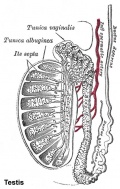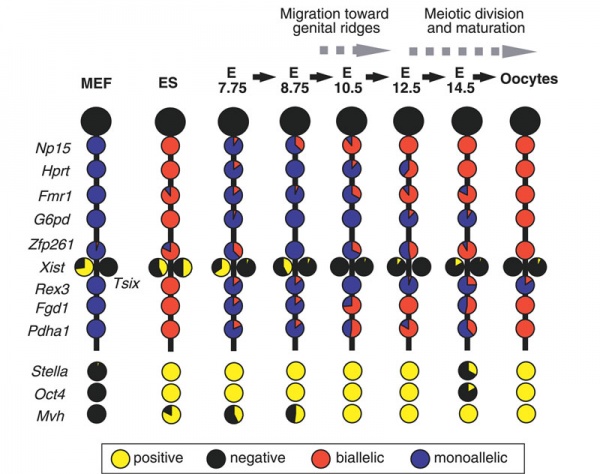Primordial Germ Cell Development: Difference between revisions
| Line 61: | Line 61: | ||
[[File:Mouse- X-linked gene expression in primordial germ cells.jpg|600px]] | [[File:Mouse- X-linked gene expression in primordial germ cells.jpg|600px]] | ||
Mouse- X-linked gene expression | Mouse- X-linked gene expression during primordial germ cell development.<ref><pubmed>17676999</pubmed>| [http://www.ncbi.nlm.nih.gov/pmc/articles/PMC1950944 PMC1950944] | [http://www.plosgenetics.org/article/info%3Adoi%2F10.1371%2Fjournal.pgen.0030116 PLoS Genet.]</ref> | ||
Each circle graph indicates the ratio of cells that are positive (yellow) and negative (black) for each gene, and biallelically (red) and monoallelically (blue) expressed in cells positive for each gene. | |||
:'''Links:''' [[Molecular_Development_-_X_Inactivation|X Inactivation]] | :'''Links:''' [[Molecular_Development_-_X_Inactivation|X Inactivation]] | ||
Revision as of 00:56, 19 November 2010
Introduction
Early in development at the time of gastrulation a small group of cells are "put aside" to later form oocytes and spermatozoa. This population of cells is described as the primordial germ cells (PGCs). These cells also migrate initially into the posterior endoderm that forms the hindgut and from there into the genital ridge that will be the site of the developing gonad. The maintenance of pluripotency within this cell population may arise through epigenetic modifications that suppress somatic differentiation programs.
This population of cells when transformed is also thought to give rise to testicular germ cell tumours.
Some Recent Findings
|
Textbooks
- Human Embryology (2nd ed.) Larson Chapter 10 p261-306
- The Developing Human: Clinically Oriented Embryology (6th ed.) Moore and Persaud Chapter 13 p303-346
- Before We Are Born (5th ed.) Moore and Persaud Chapter 14 p289-326
- Essentials of Human Embryology, Larson Chapter 10 p173-205
- Human Embryology, Fitzgerald and Fitzgerald Chapter 21-22 p134-152
- Developmental Biology (6th ed.) Gilbert Chapter 14 Intermediate Mesoderm
Primordial Germ Cell Migration
Species Comparison of Migration
Stages of primordial germ cell migration[4]
Mouse Migration Movies
| E9.0 | E9.5 | E10.5 |
| Quicktime version | Quicktime version | Quicktime version |
| Flash version | Flash version | Flash version |
X-linked Gene Expression
Mouse- X-linked gene expression during primordial germ cell development.[5]
Each circle graph indicates the ratio of cells that are positive (yellow) and negative (black) for each gene, and biallelically (red) and monoallelically (blue) expressed in cells positive for each gene.
- Links: X Inactivation
Molecular
Study has recently identified 11 genes that are specifically expressed in male and female fetal germ cells, both in vivo and in vitro, but are not expressed in embryonic stem cells.[6]
PGC Markers: alkaline phosphatase-positive, Oct4 (POU5F1), Fragilis (IFITM1)[7], Stella (DPPA3), Dazl, and Vasa (DDX4).
- Steel factor - (KITLG) a ligand for the KIT tyrosine kinase receptor.
- DAZL
- dead end - coding an RNA binding protein mainly expressed in the germ cells of vertebrates.
- Blimp1 - B-Lymphocyte induced maturation protein-1 (PRDM1)
- Prmt5 - protein arginine methyltransferase-5
- Nanog - knockdown induces apoptotic cell death in mouse migrating primordial germ cells.[8]
Abnormalities
Testicular germ cell tumours
References
- ↑ <pubmed>20845430</pubmed>
- ↑ <pubmed>19468308 </pubmed>
- ↑ <pubmed>19279135</pubmed>
- ↑ <pubmed> 20027186</pubmed>| Nature Reviews Molecular Cell Biology
- ↑ <pubmed>17676999</pubmed>| PMC1950944 | PLoS Genet.
- ↑ <pubmed>20940145</pubmed>
- ↑ <pubmed>12659663</pubmed>
- ↑ <pubmed>19906868</pubmed>
Reviews
<pubmed>20371640</pubmed>| Reproduction <pubmed>19875497</pubmed> <pubmed>19442193</pubmed> <pubmed>17446386</pubmed> <pubmed>15666347</pubmed> <pubmed>11565804</pubmed> <pubmed>11061420</pubmed>
Articles
<pubmed>19578360</pubmed> <pubmed>18953407</pubmed>
Search PubMed
Search Pubmed: Primordial Germ Cell Migration | Primordial Germ Cell | Testicular germ cell tumours
Terms
Glossary Links
- Glossary: A | B | C | D | E | F | G | H | I | J | K | L | M | N | O | P | Q | R | S | T | U | V | W | X | Y | Z | Numbers | Symbols | Term Link
Cite this page: Hill, M.A. (2024, May 2) Embryology Primordial Germ Cell Development. Retrieved from https://embryology.med.unsw.edu.au/embryology/index.php/Primordial_Germ_Cell_Development
- © Dr Mark Hill 2024, UNSW Embryology ISBN: 978 0 7334 2609 4 - UNSW CRICOS Provider Code No. 00098G



